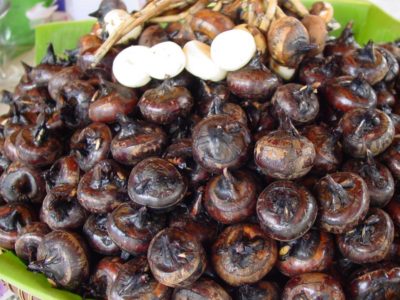
Water chestnuts in market
The Chinese water chestnut isn’t a nut at all but rather an aquatic vegetable. It’s a type of sedge, cultivated for its crisp, white, edible corms, which are actually underground stems.
This crop is native to various regions including Asia, tropical Africa, and Oceania. It thrives in shallow, waterlogged environments, and is often grown in flooded paddies, much like rice fields. It is widely utilized throughout Southeast Asian cuisines.
Chinese water chestnuts are highly valued for their distinct crunchiness, a quality they remarkably retain even after being cooked or canned. They’re a popular ingredient, commonly enjoyed raw, stir-fried, or as an addition to dishes such as soups, offering a subtle sweetness and refreshing texture.
Names
Scientific
Eleocharis dulcis
English
Chinese water chestnut
Water chestnut
Dutch
Chinese waterkastanje
Waterkastanje
French
Châtaigne d'eau
Châtaigne d'eau chinoise
German
Chinesische Wasserkastanie
Wasserkastanie
Taxonomy
Order
Poales
Family
Cyperaceae
Genus
Eleocharis
Species
Eleocharis dulcis (Chinese water chestnut)
Basic information and facts
Origin:
The Chinese water chestnut originates from Asia, tropical Africa, and Oceania.
Distribution:
It is widely cultivated across Asia, particularly in Southeast Asia, and also grows in other warm regions globally.
Annual, biennial, or perennial:
It’s a perennial plant, meaning it grows and produces year after year.
Flowers:
The plant produces small, inconspicuous flowers on spikes.
Leaves:
True leaves are absent; the plant’s green, hollow stems function as its primary photosynthetic organs.
Fruits:
The Chinese water chestnut doesn’t bear typical fruits. Its edible part is an underground stem, known as a corm.
Climate and weather:
It requires warm climates and a long growing season, thriving best in full sun.
Pollination:
Its flowers are self-pollinating, with wind potentially aiding the process. Insect pollination isn’t necessary.
Height:
The plant’s stems typically reach a height of about 1 to 1.5 meters (3 to 5 feet).
Spacing:
Individual plants are generally spaced 15 to 30 centimeters (6 to 12 inches) apart, with rows separated by 60 to 90 centimeters (2 to 3 feet).
Propagation:
Propagation is primarily done by planting small or whole corms directly into the soil.
Insect pests:
It’s relatively resistant to most insect pests, though aphids and snails can occasionally pose issues.
Harvesting:
Corms are ready for harvest when the stems turn yellow and collapse, usually 6 to 7 months after planting. Fields are typically drained before harvesting begins.
Uses:
The corms are consumed both raw and cooked. They are a popular ingredient in stir-fries and other dishes, valued for their distinctive crunchy texture.
Crop categories
Corm vegetables
Minor crops
Nuts
Subtropical crops
Tropical crops
Vegetables
Pictures

Chinese water chestnut

Chinese water chestnut

Chinese water chestnut

Water chestnut plant with tubers

Water chestnuts
